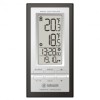Meade TE278W User Manual - Page 8
The NIST National Institute of Standards and Technology radio station WWVB is located
 |
View all Meade TE278W manuals
Add to My Manuals
Save this manual to your list of manuals |
Page 8 highlights
If there is no reception, please perform the following steps: • Bring the main unit and remote sensor close together. • Remove four (4) small screws from the back of the remote sensor with small Phillips screwdriver, and open the battery compartment. • Remove the batteries from the battery compartment and reinstall them in the same manner. Remote sensor LED indicator will flash showing transmission of the signal. • Remove the batteries from the main unit and reinstall them in the same manner. • On the main unit select the same channel number using CHANNEL button as set on the remote sensor. The remote temperature appeared on the main unit's display will show that transmission is being received successfully. TRANSMISSION COLLISION Signals from the other household devices such as wireless doorbells, home security systems, and entry control, may interfere with this product or cause temporary reception interruption. This is normal and will not affect the general performance of the product. The transmission and reception of the temperature and humidity readings will resume once the interference subsides. WWVB RADIO CONTROLLED TIME The NIST (National Institute of Standards and Technology) radio station (WWVB) is located in Ft. Collins, Colorado. It transmits an exact time signal continuously throughout the most of the continental United States at 60 KHz frequency. The unit can receive this WWVB signal through the internal antenna from up to 2,000 miles away. Due to the nature of the Earth's ionosphere, reception can be limited during the daylight hours. The radio controlled clock will search for an alternate station that receives the atomic time signal from the NIST Atomic clock in Boulder, Colorado. The WWVB tower icon on the unit's display will flash indicating a radio signal reception from the WWVB station. If the tower icon is not fully lit, or if the time and date are not set automatically, please consider the following: • During night-time hours, atmospheric disturbances are typically less severe and radio signal reception may improve. A single daily reception is sufficient enough to keep the clock accuracy within 1 second. • Make sure the unit is positioned at 8 feet (2 meters) distance from any interference source such as a TV, computer monitor, microwave, etc. • Within concrete wall rooms such as basements or office buildings, the received signal may be weakened. Always place the unit near the window for better reception. ATOMIC CLOCK Immediately after establishing communication between the main unit and remote sensor, the atomic time signal receiver will open and start to search for the atomic time signal. The search usually takes between 5-8 minutes. NOTE: Do not press any buttons on the main unit during auto search as it may interrupt product's operation, and you will need to start set up procedure again. Once the atomic time signal is received, the date and time will be set automatically, and the [ ] icon will appear. NOTE: It is necessary to set your Time Zone, having in mind that the default zone is a US Pacific Standard Time (PST). (Refer to MANUAL SETTINGS section) If the time signal has not been received in 8 minutes, you may use the MODE button to set the time and date manually. (Refer to the MANUAL SETTINGS section). After the clock is set manually, place the Weather Station by the window for the better reception. The atomic clock receiver is programmed that it will continue to search for the atomic time signal daily for every hour between 1:00 am and 4:30 am. Once the time signal has been successfully received, the time and date will be updated automatically. 8















